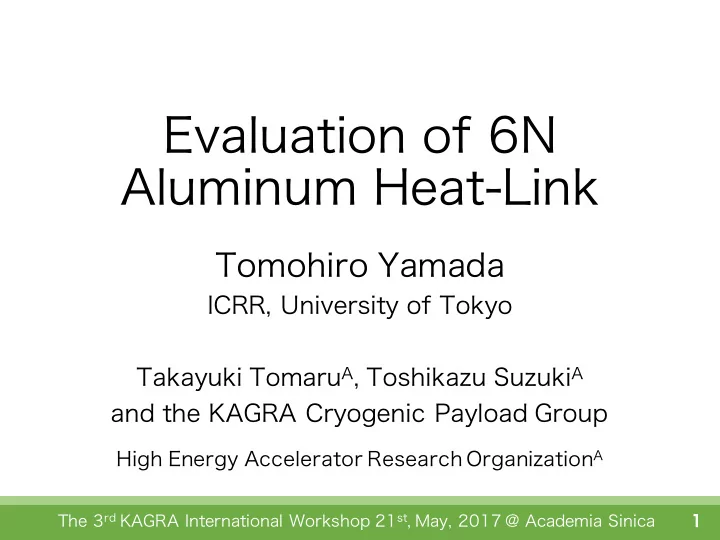

Evaluation of 6N Aluminum Heat-Link Tomohiro Yamada ICRR, University of Tokyo Takayuki Tomaru A , Toshikazu Suzuki A and the KAGRA Cryogenic Payload Group High Energy Accelerator Research Organization A The 3 rd KAGRA International Workshop 21 st , May, 2017 @ Academia Sinica
Heat-Links & Payload System Heat-links are the main path to cool down the cryogenic payload system. Heat-links are connected from the cryocooler to the payload system. We need to evaluate how much vibration is transmitted by the heat-links. by Ayako Hagiwara PT Cryocooler The 3 rd KAGRA International Workshop 21 st , May, 2017 @ Academia Sinica
What we must investigate about the Heat-link ◇ High thermal conductivity ・To reduce the number of the Heat-links -> High purity material ◇ Small spring constant : ・To reduce the transmission of vibration -> Thin wire These properties must be compatible with the requirements of the KAGRA Heat-link. => We use very thin ultra high purity aluminum ( 99.9999% (6N) ) wires. The 3 rd KAGRA International Workshop 21 st , May, 2017 @ Academia Sinica
KAGRA Heat-link & Size effect Small diameter wire ・Small thermal conduction compare to large diameter wire ・Difficulty to handle them => Stranded cable 1 Heat-link = Φ 0.15 mm × 7 × 7 × 7 Size effect : Electron mean-free-path limited by diameter of each heat-link wire. ( Total cross sectional area ~ 6 mm 2 ) The 3 rd KAGRA International Workshop 21 st , May, 2017 @ Academia Sinica
Evaluation of 6N Aluminum Heat-Link It takes a long time to measure the thermal conductivity. We can estimate the thermal conductivity ◇ What is RRR? - RRR = Residual Resistivity Ratio - RRR is an indicator of the purity of material. RRR measurement is the easiest and simplest one. We measure the RRR as a preliminary experiment. from the RRR. $ %&&' RRR = 𝑆 : electric resistance $ (.*' The 3 rd KAGRA International Workshop 21 st , May, 2017 @ Academia Sinica
RRR measurement ◇ 4 wire measurement Sample : 5N, φ0.15 mm wire 6N, φ0.15 mm wire Ⓥ Keithly Nanovoltmeter 2182 Ⓐ Keithly DC and AC current source 6221 sample Liquid Helium RRR = 𝑆 1223 𝑆 4.53 Current : ±100 mA The 3 rd KAGRA International Workshop 21 st , May, 2017 @ Academia Sinica
Results & Estimation ◇ RRR results Thermal conductivity [W/m/K] 8K 6N 5N 4 8 10 20 Temperature [K] 6N φ0.15mm : 3500 ◇Estimation of thermal conductivity 5N φ0.15mm : 3100 〈 6N φ0.15mm 〉 10 E 1 𝜆 = 1.83×10 :; ×𝑈 5 + 1.09 RRR/𝑈 ⁄ 10 4 ⁄ 8K : 𝜆 ~ 20000 W m /K F GH F IH → 110% ⁄ 20K : 𝜆 ~ 11000 W m /K 10 1 The 3 rd KAGRA International Workshop 21 st , May, 2017 @ Academia Sinica
Effects of Bending ◇ During installation of heat-links to the cryogenic payload, we’ll need to handle heat-links. We tried to evaluate the effects of bending caused by handling. ◇ How to evaluate ・wind a wire around a glass beaker 50 times ・Then, measure the RRR ◇ Results 6N : 3500 -> 2700 23% worse 5N : 3100 -> 2300 26% worse WE MUST HANDLE HEAT-LINKS CAREFULLY !! Φ 45 mm The 3 rd KAGRA International Workshop 21 st , May, 2017 @ Academia Sinica
Conclusion We need very soft material for the heat-link and one which has a high thermal conductivity. constant will be done in the near future. of transmission of vibration must be done after those measurements. • Vibration transmitted by heat-links could be an issue. • 6N aluminum heat-links are the suitable material. • RRR measurement of 6N aluminum is on-going. • Evaluation of the thermal conductivity and the spring • A calculation of cooling down time and an estimation The 3 rd KAGRA International Workshop 21 st , May, 2017 @ Academia Sinica
Recommend
More recommend